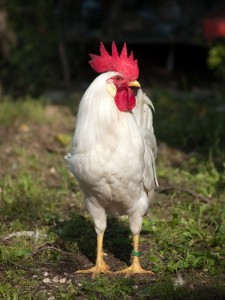Poultry Diseases
Favus
Also known as: Trichophyton megninii, Microsporum gypseum
The first symptoms include the development of lesions on non-feathered skin, such as the lower leg, comb and wattle. Some loss of feathers and skin scales may occur although there are normally no significant signs.
Favus arises through the invasion of the skin by the fungi. Lesions first develop on the comb and then often spread to produce white spots, giving the appearance of sprinkled flour. As the disease spreads concentrically, the white spots begin to scale off to give an appearance of a wrinkled crust. Although birds can recover from this, the fungus may spread to the feathered regions. When this happens, the feathers fall out in patches and thickened, crusty skin develops around the feather follicles. These can develop as depressions and are often referred to as “favus cups”. Bradley and colleagues describe the appearance of white plaques on the comb, face, and/or ear lobes followed by feather loss starting at the caudal base of the comb and progressing down the neck in chickens infected with M. gallinae (Bradley et al., 1998).
See also Mycology Online for images of infected birds and microscopic image of the causal agent.
Severe cases may result in the development of nodules and yellow caseous deposits in the respiratory tract. Young birds with well-developed wattles are most likely to be affected.
Diagnosis of favus is by histological identification of hyphae or spores in skin lesions and feather follicles and by culturing the fungus on Sabouraud dextrose agar or selective dermatophyte media.
A survey of mycological examinations on the fungal flora of chicken comb from chickens kept under a number of housing and free-range conditions revealed a wide range of fungal species with no stringent correlation between the clinical symptoms diagnosed on the chicken combs and the species of yeasts isolated. The causative agent of favus in chickens, Trichophyton gallinae, and the saprophytic yeast in pigeons, Cr. neoformans were not isolated (Gründer et al., 2005).
Control and Prevention of Favus
The condition normally only affects individuals within a flock, and spreads very slowly, by physical contact. Contamination of housing can occur, and so disinfection and the removal of infected individuals are important control measures.
There is a good self-recovery rate. German researchers have shown that infections tended to heal spontaneously after 10 weeks (Böhm and Sasu, 1973).
Treating Favus
Individuals may be treated by removal of crusts and dressing of infected areas with anti-fungal compounds. Successful treatment with topical applications of miconazole (Droual et al., 1991), and miconazole nitrate 2% have been reported (Bradley et al., 1995). Also treatment with a tincture of iodine (Mustaffa-Babjee and Oommen, 1970).
Favus has reportedly been successfully treated by rubbing lesions with an ointment of formaldehyde and vaseline. This involved melting the vaseline in a jar in a water bath and adding 5% by weight of formalin and shaking the mixture (Beach and Hairpin, 1918; Chute, 1972). Riedel (1950) described a successful single application of a quaternary ammonium compound (Riedel, 1950).
Although a number of effective treatments have been reported, mild cases normally recover without treatment (Chute, 1972). However, these cases should be isolated from the rest of the flock to prevent the further spread of infection.
Severe cases cannot be successfully treated.
Good Practice Based on Current Knowledge
When an infection occurs:
- Buildings should be thoroughly disinfected
- Badly affected birds should be killed
- Mild cases should be segregated and treated if necessary
- When adding new birds to a flock they should be inspected as these may be carrying the fungus


 British English
British English


Comments are closed.